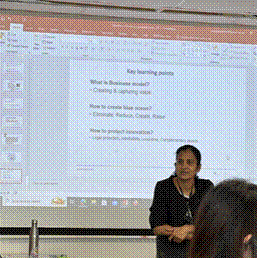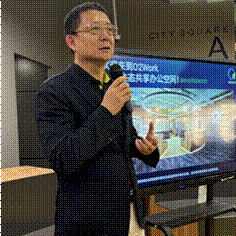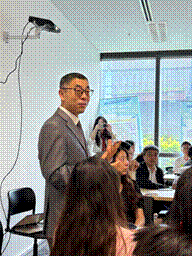International Business Major, Grade 2023 Wu Yinka
1.First Impressions of Singapore
At 14:00 on November 3, 2024, the plane landed on the runway of Changi Airport, and the unique charm of this city-state immediately greeted us. The humid tropical air outside the cabin instantly dispelled the last trace of the early autumn chill in Shanghai. The facilities at Changi International Airport are modern and comfortable, clean and tidy everywhere, more like a well-maintained and delicate home. The arrival hall and waiting area seem to be blurred, but with the help of smart navigation screens and clear multilingual signs everywhere, even a novice can quickly determine their destination. The immigration process was exceptionally smooth, and the smiles and thoughtful service of Singaporean staff made us feel at home. My nervousness about traveling abroad for the first time immediately subsided, and I followed the instructions to get my pre-purchased SIM card, successfully connecting to Singapore's 4G network, marking the official start of my Singapore trip.

When planning my trip, I did some research on Singapore and learned that it is one of the Four Asian Tigers and has the best urban infrastructure in the world. As I drove from the airport to my hotel, the scenery of Singapore rushed into my eyes, leaving me with a sense of awe at the beauty of the city. It is a green city that is hard to ignore, with well-trimmed tropical plants lining the main streets, tall and lush trees and shrubs interspersed, and flowers of various colors competing for attention. The cleanliness of the city complements the greenery, with not a speck of trash on the streets, and not even a cigarette butt or a piece of paper in sight. People only know that Singapore has strict penalties for environmental hygiene violations, but they may not realize that cleanliness and beauty seem to have become a lifestyle attitude of the people of Singapore.
I checked into my hotel in a hurry and threw my bags in my room before rushing out to explore the streets. I wanted to find something different and exotic in this tropical island nation of Southeast Asia. Singapore is a city of tall buildings, yet it does not seem so crowded. Modern and eco-friendly elements are incorporated into the architectural design, such as Marina Bay Sands Hotel and Skytree, which are not only visually striking but also effectively utilize natural energy. Despite its small size, Singapore's innovative design and energy-saving philosophy allow them to use every inch of space in the most effective way. In addition, the exterior walls of many buildings in the city are painted in light colors, which harmoniously complement the dense greenery, giving the city a modern and vibrant visual experience.
You can also see people of various skin colors and different clothing styles walking on the streets, who move about the city in an orderly manner, harmoniously forming part of the city of Singapore. The road signs and store signs here are not only in English, but also in Chinese, Malay, and other languages, projecting an irresistible atmosphere of Singapore's multiculturalism. The work and life atmosphere of ethnic tolerance and cultural tolerance seems to be telling me at all times that in this land, anyone and any culture can coexist harmoniously.
2.Academic Journey: Learning and Exchange Between Universities and Enterprises
(1) In-depth Visit to the National University of Singapore
During our eight-day study tour in Singapore, the lectures at the National University of Singapore (NUS) were undoubtedly the highlight of the journey. Not only is NUS the top university in Singapore, but it also enjoys a high reputation worldwide. As part of the study tour program, we spent four consecutive mornings at NUS, attending different units of the Innovation and Entrepreneurship course taught by Professor Anna and Wei Yu. The course uses an interactive teaching method, and the class atmosphere is lively and highly inspiring. This course is not just a lecture on theoretical knowledge, but it stimulates us to think deeply about innovation and entrepreneurship through real case analyses, group discussions, and brainstorming. Each morning, Professor Anna would arrange different themes for discussion, ranging from the cultivation of innovative thinking to market analysis, and then to the acquisition of entrepreneurial resources. Each aspect was combined with real-life cases, making them vivid and concrete. During the class, Professor Anna paid great attention to interaction, encouraging us to ask questions and participate in discussions at any time. She would guide and probe different viewpoints to help us look at the same matter or phenomenon from different angles. Every day of the course brought new insights and reflections, and Professor Anna, with her rich experience and insightful analysis, built a framework of innovation and entrepreneurship thinking, which made me think more deeply about my future career planning.


In addition to our classes, we spent an afternoon touring the National University of Singapore, whose infrastructure undoubtedly reflects its status as a top global university. From modern teaching buildings to spacious and comfortable libraries, everything was impressive. The university's architecture is modern and design-oriented, with many teaching buildings covered in greenery, a vertical greening design that is both visually appealing and environmentally friendly. The bright and spacious classrooms equipped with advanced multimedia teaching equipment provide students with an excellent learning environment. In addition to learning facilities, NUS also has several distinct leisure areas, providing students with places to relax and socialize. For example, the many cafes and student lounges in the campus provide students with a variety of places to enjoy their free time. Students can read, chat, and even discuss academic topics here. The design of these places makes people feel warm and cozy, serving as both a place to take a break and a space for student interaction and cooperation. The students from various countries who gather here make the entire NUS campus diverse and inclusive, creating a harmonious and upward-looking atmosphere that broadens my international perspective and makes me understand the importance of respecting and accepting different cultures.

(2) o2work Business Tour
o2work is an innovative company that specializes in providing shared office spaces, with the philosophy of creating green office spaces and a commitment to creating suitable working environments for various start-ups, freelancers, and small teams. By visiting o2work's spaces and interacting with its management, I gained a deeper understanding of Singapore's entrepreneurial culture and the shared economy model.
Upon entering o2work's office area, I was greeted by a fresh and modern atmosphere. The space design integrates green elements seamlessly, with various green plants filling the space, making the working environment both eco-friendly and vibrant. The management explained that o2work not only emphasizes the functionality of office spaces, but also focuses on creating a healthy working environment by using green wall and air purification systems to enhance employees' work experience. This design philosophy was refreshing, especially in a hot and humid city, where the addition of greenery and nature made the space more comfortable and pleasant. o2work's office model is very suitable for start-up teams, as they can rent office space on demand, with flexible lease terms and sizes to accommodate the needs of different stages of the team. What's more, o2work not only provides office facilities, but also regularly organizes exchange activities among entrepreneurs to create a community ecosystem that supports cooperation and sharing. Here, office workers are no longer isolated individuals, but partners who support each other, creating a strong atmosphere of collaborative innovation.
What also struck me as coincidence was that Professor Wei and the entrepreneurs of o2work were actually Inner Mongolian hometown friends, which made me truly realize the true meaning of the world being both big and small.

(3) Visit Nanyang Technological University (NTU)
NTU attracts many visitors with its unique architectural style and culturally rich campus layout. Our bus stop is located near the famous dumpling building - The Hive. The building resembles a stacked steamer basket from the outside, and its unique design and green environmental concept have made it one of NTU's landmarks. Consisting of 12 cylindrical towers, each floor resembles a layered steamer basket, with plants covering the exterior, creating a unique vertical green landscape. The Hive not only has a novel appearance but also combines energy-saving design, with good ventilation systems keeping the interior air flowing comfortably. Its open space layout also encourages student interaction and communication, providing flexible spaces for learning and discussion.

I accompanied Professor Wei and another colleague as we walked and snapped photos, eventually arriving at a Chinese-style garden that added a touch of Chinese traditional culture to the campus. The garden featured artificial mountains and flowing water, stone pathways, and evergreen pine and cypress trees, exuding a strong Eastern charm. It seemed like a sanctuary for the soul, providing a peaceful and relaxing environment for students to rest or ponder, and appreciate the serene beauty of nature. This garden provided a striking contrast to the modern xiao long bao architecture, showcasing Nanyang Technological University's inclusiveness and integration of diverse cultures in the collision between technology and culture.

The NTU campus is vast, and to facilitate the movement of students and faculty, it has a dedicated on-campus bus service, similar to NUS, which provides seamless connectivity across the entire campus. Many students opt to take the shuttle bus between different academic buildings, saving them time and allowing them to enjoy the scenery of the campus during their commute. The entire shuttle system is both convenient and environmentally friendly, showcasing Nanyang Technological University's innovative practices in green transportation.
(4) Participating in the Seminar of Singapore-China Science and Technology Industrial Innovation Center
During my study in Singapore, I had the privilege of attending the seminar of the Singapore-China Science and Technology Industrial Innovation Center, which gave me a deeper understanding of the cooperation opportunities between the two countries in the field of science and technology innovation, as well as the center's efforts in promoting science and technology exchanges and industrial cooperation between China and Singapore.
The Singapore-China Science and Technology Industrial Innovation Center is a platform aimed at promoting cooperation between the two countries in the fields of science, technology, and industry. At the seminar, Director Ro Ruikang introduced the center's development goals and future vision, especially how to promote in-depth cooperation between enterprises and academic circles of the two countries through innovative projects. The center not only provides comprehensive support for Chinese enterprises to land in Singapore, but also serves as a bridge for Singaporean enterprises to enter the Chinese market. Through this platform, many emerging technology companies and startups can get support in policy, resources, and funding, thus accelerating the process of product development and marketization.
The seminar made me deeply feel the increasingly close cooperative relationship between science and technology industries in the context of globalization, especially between China and Singapore, where science and technology innovation undoubtedly serves as an important driving force for economic development of both sides. I am full of expectations for the prospects of future cooperation in this field.


3. Cultural Journey
(1) Marina Bay Sands and Universal Studios Singapore
In Singapore's tourist attractions, Marina Bay Sands and Universal Studios Singapore are among the most representative ones. Marina Bay Sands is one of Singapore's landmark attractions. The Merlion statue stands majestically in the center of the park, with its imposing figure and spraying water column becoming a popular spot for tourists to take photos. Standing beside the Merlion, looking out over the vast bay before me, I couldn't help but marvel at the unique charm of Singapore City and its harmonious coexistence with nature. It's not just a tourist attraction, but also a symbol of Singapore's culture and history. The Merlion represents Singapore's rise from a port city to a global metropolis.

Sentosa Island, on the other hand, is a popular holiday destination in Singapore. The beaches, green spaces, and luxurious resorts on Sentosa Island allowed me to fully relax both body and mind. At Universal Studios on Sentosa Island, I experienced the boundless charm of modern entertainment industry. Sentosa is not just a tourist attraction, but more like a vibrant and fun leisure paradise. Every scenic spot on the island left me with a lasting impression, whether I was taking a leisurely walk along the beach or exploring world-class attractions. The only regret was that I didn't have enough time to visit Universal Studios due to time constraints, but I think travel always leaves some regrets, which makes the experience more memorable.

(3) Conversation with Professor Wei
One of the most memorable moments of my study abroad journey was a casual chat with Professor Wei Jingfu after dinner. On the night when all courses at NUS had ended, Professor Wei invited the three of us international business students to have tea and chat in the hotel lobby. I was very grateful to have this opportunity and we talked about the history, culture, and things we had seen and experienced in Singapore. Professor Wei also shared with us his years at SUTD and recalled how he had studied in Japan and then returned to serve academically. In our field, being inspired by a globally-minded thinker professor while studying abroad has given me a more three-dimensional understanding of Singapore and has made me more eager for the future. I must believe in the infinite possibilities of the future! Professor Wei particularly emphasized this point, encouraging us young people to have the courage to try. The conversation with Professor Wei made me realize the close connection between academic research and the real world, and I have become more aware of the importance of the power and depth of academic thought. This also adds many memorable moments to my study abroad journey.
Conclusion
This study tour in Singapore was a rewarding experience for me, as every interaction and learning experience here allowed me to think more deeply. I fell in love with Singapore during this visit, and the city deeply touched me. If given the chance, I would come back again.
November 17th, 2024

